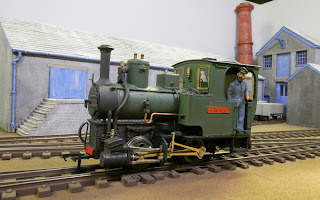A Magic Train
Having received a request to provide a few more details of my Fleischmann Magjc Train conversion ‘Hercules’, so when photographing the recently completed clay dry buildings, I dusted off ‘Hercules’ and put it in front of the camera.
Currently there is the excitement of the forthcoming 7mm scale ready to run Lynton & Barnstaple locos and stock from Lionheart, the first British outline rtr models in our scale. But they’re not the first ready to run stock that the O-16.5 modeller could take advantage of.
Just over two decades ago, I returned to the East Midlands after university and reacquainted myself with the Trent Valley Group of the 7mm Narrow Gauge Association where the late Tim Allsopp had taken Bachmann’s 0n30 rtr Porter under the scalpel and unfollowed suit. After this, Tim moved on to the larger locos that Bachmann brought out which were a bit big for me.
Instead, I looked to the other rtr range that was available, the Fleischmann Magic Train loco, which was much more my size and more my area of interest.
We’d spent several holidays travelling round Europe in parents’ camper van growing up where I’d seen a few O&K well tank locos. Plus we’d holidayed in Tywyn since we were young and subsequent volunteering on the Talyllyn had brought me in to contact with ‘Douglas’, the Andrew Barclay copy of the O&K and ‘Tom Rolt’ the much rebuilt larger version.
Being designed as children’s toys there were various versions of the Magic Train loco and I was able to pick up one of the ones with the greater level of detail and full valve gear.
Before the Great War, Orenstein & Koppel and other German firms had agents in Britain and were able to tender for locos, rolling stock and track contracts in the same manner as British builders such as Hunslet with some success.
Two surviving locos had caught my eye in the books that I had available, the Freudenstein at Penlee and the Orenstein & Koppel loco ‘Eigisu’ that after working on civil engineering contracts ended up at Penrhyn Quarry. Since then, I’ve seen photos of a couple of other German supplied locos in this country, one at least in Cornwall, so appropriate for Wheal Ponder and thoughts turned to converting the Magic Train to resemble something similar. Notably, a loco that had been in Britain a few years and had a few modifications made to it.
The Magic Train locos are almost all plastic construction so easy to work with. The first step was to remove the plunger pick ups fitted to allow for poorer track cleanliness. This improved the look of the loco immediately and with clean wheels and track the loco has always run well. Next up was to sand off all the moulded on detail to give a blank canvas to start again.
First stage was to collect together the castings and fittings needed to put the detail back on. This project was tackled just after I’d built the Kerr Stuart Skylark kit from Wrightlines and the similarity size wise resulted in additional chimney and smoke box door castings being obtained which got the project started. I’d collected a selection of loco fittings and have a well stocked bits box. The whistle is a Ron Chaplin turning, the safety valves came off a Smokey Joe, the remainder- boiler feed clacks, cylinder lubricators, pipe unions, lamp brackets and cab fittings came from either Laurie Griffin or the Wrightlines loco detailing pack.
Having now volunteered on the Talyllyn footplate for over thirty years, adding detail to locos is one aspect of model making that I find most enjoyable, plus sets my OCD galloping away and this loco was no exception. When built it was intended to run on our Group’s ‘Henmore Dale’ layout hence the vacuum braking, something I might omit these days.
Two decades on, my Magic Train conversion still fits in with the locos I’ve built since. It runs well and I enjoy watching the outside Stephensons valve gear go round as something a little different to the more widespread Walschaerts.





Comments
Post a Comment